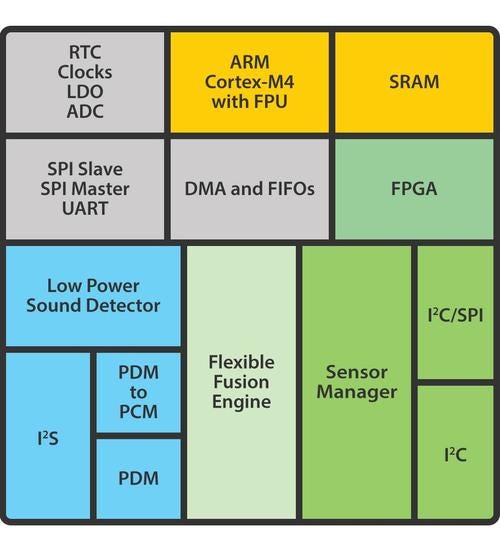QuickLogic Claims World's Most Advanced Sensor Processing SoC
August 14, 2015

Looking to develop next-generation mobile, wearable, and IoT devices that consume as low as 12 microwatts of power from a coin cell battery? QuickLogic Corp., an innovator of ultra-low-power programmable sensor processing products, says it has the solution with its EOS S3 sensor processing platform, which was unveiled on July 30.
The EOS platform is described to incorporate an architecture that enables the most advanced and computationally intensive sensor-driven applications at a fraction of the power consumption of competing technologies.

EOS Sensor Platform
Design News discussed specifics about the system-on-chip sensor platform with Brian Faith, QuickLogic’s vice president of business development. Faith stated that the key features that differentiate the EOS platform from ARM Cortex-M-based microcontroller manufacturers include the "unique" multicore SoC that provides a tiered architecture with world-class computational capability at industry-leading power levels. It also is said to deliver 80% more computing capability than traditional ARM Cortex-M4F-based microcontroller sensor hub solutions, and dedicated voice processing architecture enables always-on voice applications at less than 350 microamps. The platform uses three dedicated processing engines.
Faith explained that the EOS platform provides a sensor manager dedicated to managing all front-end sensor operations by way of an electronic controller. Also, a circuit block embedded with the SoC’s multicore processor that the company calls Flexible Fusion Engine is provided to optimize real-time sensor processing. The power requirements for this optimization task are 50 microwatts/MHz and approximately 12.5 microwatts/DMIPS for sensor functions. Finally, a Cortex-M4 microcontroller with a floating-point unit is optimized for lower power consumption of 100 microwatts/MHz and approximately 80 microwatts/DMIPS for general-purpose tasks.
MORE FROM DESIGN NEWS: Parallax Propeller Packs Eight 32-Bit Cores in a 40-Pin MCU
The Flexible Fusion Engine (FFE) and sensor manager handle the bulk of the algorithm processing, which minimizes the duty cycle for the floating-point microcontroller. This approach dramatically lowers aggregate power consumption to enable sensor-driven mobile, wearable, and IoT devices, which need to be stingy with power. Applications include pedestrian dead reckoning, indoor navigation, motion-compensated heart rate monitoring, and other advanced biological applications within their power budgets.
SenseME Algorithm Library
Another product innovation that QuickLogic’s EOS S3 platform has provided for mobile, wearable, and IoT designers is the SenseME algorithm library. It allows real-time processing of sensors to occur by way of an real-time operating system. The SenseME library works with a variety of RTOS products and is compliant with the Android Lollipop operating system, as well. An added feature with the SenseME library is that since the EOS is a sensor- and algorithm-driven platform, it can support third-party and customer-developed algorithms. The development of these algorithms is achievable by way of using QuickLogic’s industry-standard Eclipse Integrated Development (IDE) plugin. The Eclipse IDE is QuickLogic’s algorithm development platform of choice because of its optimization and proven code generation tools, along with a feature-rich debugging environment that allows quick porting of existing code into both the EOS platform’s FFE and ARM Cortex-M4F microcontroller.
Sensor Processing Market and Applications
QuickLogic cited research data published by IHS iSuppli forecasting the total market for sensor processing solutions in smartphone, tablet, and wearable applications will reach 2 billion units in 2019. QuickLogic’s EOS S3 is aimed at leadership in the power-efficient sensor hub market. Tom Hackenberg, principal analyst at IHS Technology, stated:
"We expect that the annual market for embedded processors as sensor hubs in handsets, tablets and wearable health and fitness devices will exceed 2.0 billion units by 2019. This market growth is driven by an increase in the number of sensors in each product as the devices transition from simple products like pedometers, to sophisticated, multipurpose devices that feature always-on capabilities. Providing these demanding capabilities without sacrificing battery life makes power consumption a major factor in the success of these advanced devices. Power efficient sensor hubs, such as QuickLogic’s EOS platform, will be the enabling hardware that allows device designers to quickly and easily incorporate multiple advanced features without increasing power drain."
Some of the target applications QuickLogic is exploring include but are not limited to:
• Always-on, always-listening voice recognition and triggering
• Pedometry, pedestrian dead reckoning, and indoor navigation
• Sports and activity monitoring
• Biological and environmental sensor applications
• Sensor fusion, including gestures and context awareness
• Augmented reality
• Gaming.
MORE FROM DESIGN NEWS: TI's MSP432 MCU Provides 32-Bit Performance, Low-Power Capability
Samples of the EOS platform will be available in September. The site www.quicklogic.com/EOS has more information.

We’re heading to Philly! Design & Manufacturing Philadelphia will take place Oct. 7-8. Get up close with the latest design and manufacturing technologies, meet qualified suppliers for your applications, and expand your network. Learn from experts at educational conferences and specialty events. Register today and join us at Philadelphia’s premier industry showcase!
Don Wilcher is a passionate teacher of electronics technology and an electrical engineer with 26 years of industrial experience. He’s worked on industrial robotics systems, automotive electronic modules/systems, and embedded wireless controls for small consumer appliances. He’s also a book author, writing DIY project books on electronics and robotics technologies. His latest book, Make: Basic Arduino Projects, published by Maker Media, is on the Alabama State Department’s approved Career and Technical Education (CTE) reading list. He’s currently developing 21st century educational training products and curriculum focusing on Internet of Things (IoT) and Industrial Physical Computing for makers, engineers, technicians, and educators. Besides being an Electrical Engineer, he’s a Certified Electronics Technician with ETA International and Alabama State Certified Electronics Instructor.
About the Author(s)
You May Also Like


.jpg?width=300&auto=webp&quality=80&disable=upscale)


